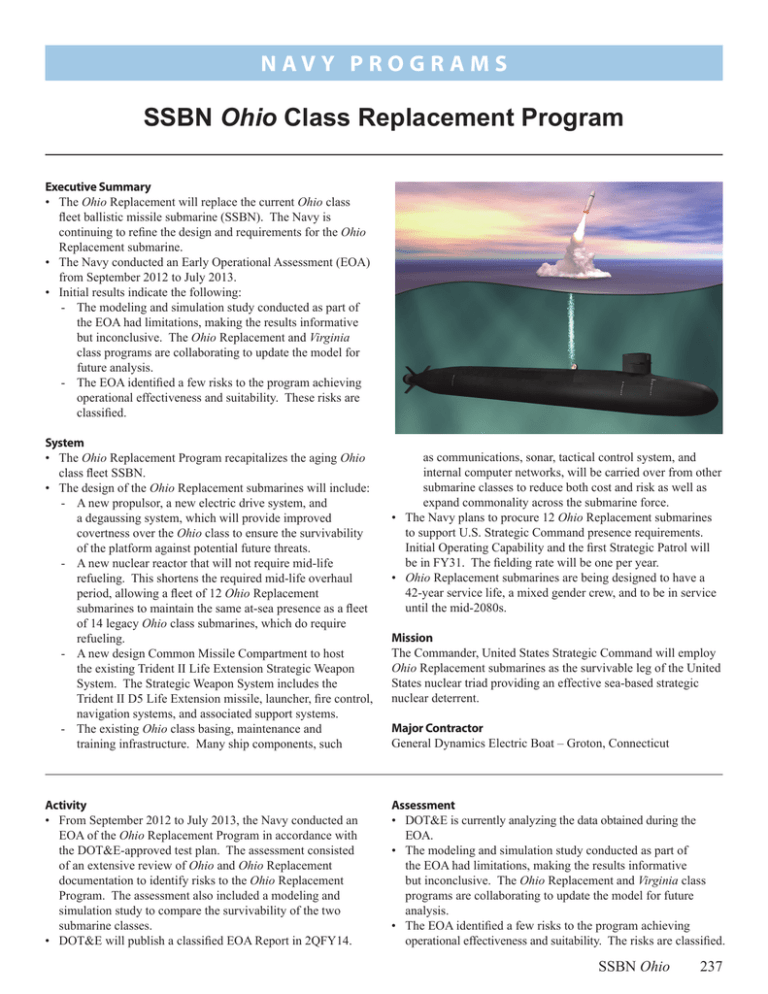Ohio N a v y P R O G...
advertisement

N av y P R O G R A M S SSBN Ohio Class Replacement Program Executive Summary • The Ohio Replacement will replace the current Ohio class fleet ballistic missile submarine (SSBN). The Navy is continuing to refine the design and requirements for the Ohio Replacement submarine. • The Navy conducted an Early Operational Assessment (EOA) from September 2012 to July 2013. • Initial results indicate the following: - The modeling and simulation study conducted as part of the EOA had limitations, making the results informative but inconclusive. The Ohio Replacement and Virginia class programs are collaborating to update the model for future analysis. - The EOA identified a few risks to the program achieving operational effectiveness and suitability. These risks are classified. System • The Ohio Replacement Program recapitalizes the aging Ohio class fleet SSBN. • The design of the Ohio Replacement submarines will include: - A new propulsor, a new electric drive system, and a degaussing system, which will provide improved covertness over the Ohio class to ensure the survivability of the platform against potential future threats. - A new nuclear reactor that will not require mid-life refueling. This shortens the required mid-life overhaul period, allowing a fleet of 12 Ohio Replacement submarines to maintain the same at-sea presence as a fleet of 14 legacy Ohio class submarines, which do require refueling. - A new design Common Missile Compartment to host the existing Trident II Life Extension Strategic Weapon System. The Strategic Weapon System includes the Trident II D5 Life Extension missile, launcher, fire control, navigation systems, and associated support systems. - The existing Ohio class basing, maintenance and training infrastructure. Many ship components, such Activity • From September 2012 to July 2013, the Navy conducted an EOA of the Ohio Replacement Program in accordance with the DOT&E-approved test plan. The assessment consisted of an extensive review of Ohio and Ohio Replacement documentation to identify risks to the Ohio Replacement Program. The assessment also included a modeling and simulation study to compare the survivability of the two submarine classes. • DOT&E will publish a classified EOA Report in 2QFY14. as communications, sonar, tactical control system, and internal computer networks, will be carried over from other submarine classes to reduce both cost and risk as well as expand commonality across the submarine force. • The Navy plans to procure 12 Ohio Replacement submarines to support U.S. Strategic Command presence requirements. Initial Operating Capability and the first Strategic Patrol will be in FY31. The fielding rate will be one per year. • Ohio Replacement submarines are being designed to have a 42-year service life, a mixed gender crew, and to be in service until the mid-2080s. Mission The Commander, United States Strategic Command will employ Ohio Replacement submarines as the survivable leg of the United States nuclear triad providing an effective sea-based strategic nuclear deterrent. Major Contractor General Dynamics Electric Boat – Groton, Connecticut Assessment • DOT&E is currently analyzing the data obtained during the EOA. • The modeling and simulation study conducted as part of the EOA had limitations, making the results informative but inconclusive. The Ohio Replacement and Virginia class programs are collaborating to update the model for future analysis. • The EOA identified a few risks to the program achieving operational effectiveness and suitability. The risks are classified. SSBN Ohio 237 N av y P R O G R A M S Recommendations • Status of Previous Recommendations. This is the first annual report for this program. • FY13 Recommendation. 1. The Navy should update and accredit the acoustic and threat models for the next operational assessment to reduce modeling and simulation limitations. 238 SSBN Ohio







